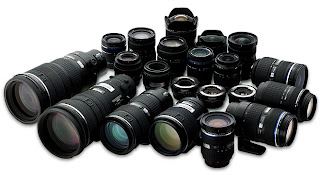Tips for choosing lenses for Digital SLR cameras
 |
| Image: tiptopphotography.wordpress.com |
Tips to understand and mix and match
between the digital SLR camera with a lens as needed.
If you are
a beginner in the world of photography you may want to soon have a new lens
than the kit lens you already have. Before you buy a lens, you make sure the
field of photography to be your field, whether traveling or photography
landscape photography, architecture, macro photography, photography for
weddings or journalism
photography. If you already understand how mixing and matching between the lens and digital SLR camera, then you do not need to carry a camera, and lens equipment as a photographer in this photo.
Lenses can be categorized into several classes
based on specific categories, which include:
Focal length
The shorter the focus of an increasingly wide-view lens obtained, or also called wide angle lens / wide angle lens. The focal lengths of the lens while the narrower point of view but the higher magnification of the recorded object, or often referred to as the zoom lens. Judging from the focal length and usefulness, we can categorize the lens into several classes, among others:
Wide and ultra wide angle lens
This
lens has a focal 35 mm or shorter. The wider the angle of view lens more the objects recorded, this type of lens is perfect for photographing landscapes
(landscape), buildings, activities that involve a lot of people like the
traditional ceremonies, dances, or a large family photo. In addition to the
wide angle lens is very useful when you are close to the object that you want
to photograph. These lenses also provide 3-dimensional effect on the resulting
image.
Standard
lens.
Has
focused 50 or 55 mm, this lens is usually the lens is also an innate / kit lens
when we buy a new camera. This type of lens is suitable for day-to-day needs in
the photograph.
Telephoto lenses.
Focal
length lens (focal length) lens ranges from 85-200 mm. Long enough for you to
take pictures of objects that are not too close to you, for example, a candid
photograph of children who were playing without disturbing their game, or focus
on a candid photograph dancer dancers among others.
Super Telephoto lens.
With a
focal length of 300-800 mm, extreme lens is suitable for taking pictures of
wildlife such as birds were in the nest, or maybe even photographing wild
animals even without having to reposition ourselves in danger with him. This
type of lens is also frequently used in the world of sports. High cost and the
long form and weight makes this lens is usually only used by serious
photography enthusiasts.
Fixed Lens and Zoom Lens.
 |
Fix focus
lens has a fixed value, or more simply the lenses cannot be used to zoom the
object, meaning that you have to run toward or away to zoom in / out objects.
The advantage of this lens is smaller than the zoom lens, as well as the
results obtained sharper. Fix lens also has a wide opening so as to produce the
effect of blur / bokeh better. Zoom lens has a focal range of purposes, such as
focusing lenses 18-135 mm. Excess is the flexibility of zoom lens, the one we
can get focus lens for wide angle and zoom lenses as well. The disadvantage is
the large size and sharpness quality of the results obtained are still below
the fixed lens.
Fix & Variable Aperture
Some
lenses are also made with a fixed aperture, with aperture diaphragm that cannot
be changed. Lenses like this are usually worth relatively expensive compared to
lenses with variable aperture (aperture change focal length follow-fox)
Fast Lens.
 |
| Image: darkroastedblend.com |
Important note before buying lenses:
So how do
we choose the lens? The first of course to ask yourself what you need. Is it
only for the purposes of taking a trip with a holiday or special interest such
as photographing landscapes (you need a wide angle lens or zoom lens), or the
wild life (requires a telephoto or super-telephoto lens).
Some other tips and solutions that you
can consider before buying lenses include:
1. Faster
lens is better than a slower lens. Choose a lens with f values as small as
possible.
2. Lens
with a fixed aperture (f value is fixed) is better, although these lenses are
usually high-priced.
 |
| Image: neeshu.com |
4.
Consider also the quality of the lens material if you have more funds. Some
upscale lenses are made with good materials and even resistant to weather
changes.
5. Before
buying a lens, make sure you choose the lenses fit your budget and needs. If
your budget is not enough to buy the original lens (OEM) in accordance with
your camera, then you can buy a used lens or third party lenses manufactured by
Sigma, Tamron, Tokina or Samyang. Now Tamron, Rokinon or Sigma lenses have been
produced specifically lenses for Canon, Sony or Nikon with good quality. Tokina
and Samyang also have been producing high quality for the special and specific
needs. If the Sigma and Tamron has produced almost all types of lenses, the
Samyang and Tokina make lenses more unique that may not have been made by
Canon, Nikon, Pentax, Sony or other lens factory like Rokinon, Carl Zeiz,
Leica, Olympus, and Panasonic or by Sigma and Tamron.
If you are serious about photography, then you will find many kinds of lenses such as fish-eye lens, lens baby and forth like a lens to the needs of the police investigation at the crime scene, the lens for photos of stars, and the lens to support the military, scientific and lenses to science knowledge.
*) Lens
OEM (Original Equipment Manufacturer).




Comments
Post a Comment